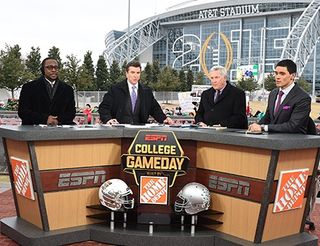From Playoff Come Big Payoffs

Related: The Year in Sports: CBS’ Man for All Seasons
Related: Sports Cable Power Has Eyes on NCAA Final Prize
For years, college football fans, coaches, administrators, players, pundits and politicians clamored for a playoff to determine the top team in the land. Last season, they got their wish and ESPN got a new hit show, the four-team College Football Playoff that debuted to the three largest audiences in cable television history.
The playoff was advertising—and ratings—gold for ESPN, which is paying a reported $13.2 billion for rights to the games for 12 years. Advertisers spent as much as a reported $1 million on 30-second spots for the national championship game in January.
Ilan Ben-Hanan, ESPN VP of college sports programming and a lead architect of the College Football Playoff agreement, says the inaugural event’s performance exceeded expectations. “We’re very pleased to be the rights holder and we see the value of the property,” he says. “To be part of creating a mega-event on the sports calendar is something that we at ESPN are very, very proud of. We’re thrilled to be involved.”
ESPN’s College Football Playoff coverage—B&C’s Sports Show of 2015 pick—recorded the top-three Nielsen cable numbers ever—33.4 million for Ohio State’s win over Oregon in the national championship game Jan. 12, 28.3 million for Ohio State’s victory over Alabama in one of the New Year’s Day semifinals and 28.2 million for Oregon’s win over Florida State in the other New Year’s Day game. The three playoff games averaged 29.8 million viewers and a 16 rating.
“College Football Playoff is a sensational property for ESPN—I’d argue it’s the company’s best—and last year’s viewership numbers were no surprise to those who understand the fervor of college football fans and the long-term desire for a playoff,” Sports Illustrated writer Richard Deitsch says. “Obviously, some of the ratings will be dictated yearly by match-ups but this will be a long-term success for ESPN. The College Football Playoff is that rare sports property—destination viewing for sports fans.”
Broadcasting & Cable Newsletter
The smarter way to stay on top of broadcasting and cable industry. Sign up below
ESPN is venturing into tougher ratings terrain this year—New Year’s Eve. The semifinals will be played on New Year’s Eve eight years under terms of ESPN’s contract with the College Football Playoff organization. Championship games are all played on Monday nights; this season’s college football “Super Bowl” will be held Jan. 11 at University of Phoenix Stadium in Glendale, Ariz.
“People love their college football, it’s been proven many times that it’s a kind of you-build-it-they-will-come mentality,” Ben-Hanan says. “Look at the opening rounds of the NCAA basketball tournament. Those games are on during the workday and that has not stopped fans from finding [them].
“Certainly there’s a lot going on New Year’s Eve and we all recognize that, but we live in a world where fans can access those games wherever they are,” Ben-Hanan adds. “We make sure it’s part of ESPN’s DNA that we are wherever the fans are, so if fans are out at a party and want to watch the games on their phone or their tablet, that’s fine, If they want to check in with their hosts at a New Year’s Eve party and make sure that ESPN is on the TV as they’re counting down to New Year’s, that’s fine too.”
The College Football Playoff replaced the widely panned Bowl Championship Series, which used computer rankings and polls to choose two teams to play for the championship. The new playoff system is open to more teams and involves a committee that selects and seeds four teams that will play for the national title. There have been calls to expand the playoff field, which SI’s Deitsch, among others, sees as inevitable.
“I think the money is too great for the playoffs not to eventually expand to eight teams,” Deitsch says.
The playoff also is paying off for ESPN by creating even more of a buzz all season long for college football, which is a sizable segment of the company’s programming.
“You’re in a world now where if you’re a fan on a college football Saturday during the regular season, there could be a half-dozen, even a dozen games, that have an important impact on the national championship picture,” Ben-Hanan says. “I think that was the biggest takeaway. This was just not about transforming what happens on New Year’s Eve and New Year’s Day, it wasn’t just about doubling the amount of teams eligible to compete from two to four, it’s about what happens all year long in college football and that’s been a pleasant surprise.”
